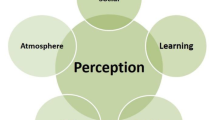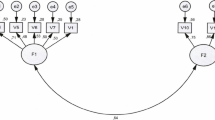Abstract
The purpose of this research was to develop and validate a new instrument, the Mental State in Learning Environment Questionnaire (MSLEQ), to assess student's mental state in a given learning environment. The MSLEQ has high internal consistency reliability values between 0.70–0.92 as well as good construct validity and predictive validity. After conducting a factor analysis, four main factors were extracted and were described as ‘emotion’, ‘intention’, ‘internal mental representation’ and ‘external mental representation’. The important feature of this study is the construction of an economical questionnaire on the mental state in a given learning environment. The questionnaire yielded important information that can be concretely applied to science teaching and learning.
Similar content being viewed by others
References
Arbuckle, J.L. & Wothke, W. (1999). Amos 4.0 user's guide. Chicago: SPSS Inc.
Bagozz, R.P. & Yi, Y. (1988). On the evaluation of structural equation models. Academic of Marketing Science, 16, 76–94.
Bentler, P.M. & Bonett, D.G. (1980). Significance tests and goodness of fit in the analysis of covariance structures. Psychological Bulletin, 88(3), 588–606.
Bull, S. & Solity, J. (1993). Classroom management. New York: Croom Helm.
Carmines, E.G. & Mclver, J.P. (1981). Analyzing models with unobserved variables: Analysis of covariance structure. In G.W. Bohmstedt and E.F. Borgatta (Eds.), Social measurement: Current issues (pp. 65–115). Beverly Hills, CA: Sage.
Chiu, M.H., Chun, C.C. & Liu, C.J. (2002). Dynamic processes of conceptual change: Analysis of constructing mental models of chemical equilibrium. Journal of Research in Science Teaching, 39(8), 688–712.
Davitz, J.R. (1969). Terminology and concepts in mental retardation. New York: Teachers College Press.
Davitz, J.R. (1970). Effects of sensitivity training on identification of emotional meaning with and without the use of an electronic band-pass filter. Washington, DC: American Educational Research Association.
Dienes, Z. & Perner, J. (1999). A theory of implicit and explicit knowledge. Behavioral and Brain Sciences, 22(5), 735–808.
Doane, S.M., Mannes, S.M., Kintsch, W. & Polson, P.G. (1992). Modeling user command production: A comprehension-based approach. User Modeling and User Adapted Interaction, 2, 249–285.
Doane, S.M., Sohn, Y.W., Adams, D. & McNamara, D.S. (1994). Learning from instruction: A comprehension-based approach. In Proceedings of the 16th Annual Conference of the Cognitive Science Society (pp. 254–259). Atlanta, GA: Erlbaum.
Doane, S.M., Sohn, Y.W., Adams, D. & Barnes, M.J. (2000). Modeling the intuitive commander. ARL Technical Report, U.S. Army Research Laboratory, Ft. Huachuca, AZ.
Fraser, B.J., Giddings, G.J. & McRobbie, C.J. (1995). Evolution and validation of a personal form of an instrument for assessing science laboratory classroom environment. Journal of Research in Science Teaching, 32, 399–422.
Fraser, B.J. (1998). Science learning environments: Assessment, effects and determinants. In B.J. Fraser & K.G. Tobin (Eds.), International handbook of science education (pp. 53–66). Dordrecht, The Netherlands: Kluwer Academic Publishers.
Fraser, B.J. (2003). Research in learning environment. Presented in the Conference of Learning Environment, Kaohsiung, Taiwan.
Gifford, R. (1997). Environmental psychology: Principles and practice (2nd ed.). Boston, MA: Allyn & Bacon.
Graetz, K.A. & Goliber, M.J. (2002). Designing collaborative learning places: Psychological foundations and new frontiers. New Directions for Teaching and Learning, 92. Winter.
Gussarsky, E. & Gorodetsky, M. (1990). On the concept “chemical equilibrium”: The associative framework. Journal of Research in Science Teaching, 27, 197–204.
Husserl, E. (1984). Logische untersuchungen (Zweiter Band Zweiter Teil) (Logical investigation (Vol. 2, Part 2)). Berlin: Martinus Nijhoff Publisher.
Liu, C.J. (2002). The effect of mental state in learning science concept. Presented in the 41th Annual Conference in Psychology, Taiwan.
Liu, C.J. (2003). The study on the relationship between student's mental state and the learning environment. Presented in Third International Conference on Science, Mathematics and Technology Education, South Africa.
Liu, C.J. & Hou, I.L. (2004). The study in mental states of the ninth grade students in learning about the concepts of plate tectonics. Journal of Science Education (Chinese) (in press).
Mason, L. (2003). Personal epistemologies and intentional conceptual change. In G.M. Sinatra & P.L. Pintrich (Eds.), Intentional conceptual change (pp. 199–236). Mahwah, NJ: Lawrence Erlbaum Association, Inc.
McKendree, J., Small, C., Stenning, K. & Conlon, T. (2002). The role of representation in teaching and learning critical thinking. Educational Review, 54(1), 57–67.
Ministry of Education, Taiwan (2002). Principles of K-9 integrated science curriculum. Taipei: Author.
Perner, J. (1991). Understanding representational mind. Cambridge, MA: MIT Press.
Purton, A.J. (1998). Mental state attribution. Halifax, Nova Scotia: Dalhousie University.
Robert, S. & Pashler, H. (2000). How persuasive in a good fit? A comment on theory testing. Psychological Review, 107, 358–367.
Simon, H.A. & Kaplan, C.A. (1991). Foundations of cognitive science. In M.I. Posner (Ed.), Foundations of cognitive science (pp. 1–47). Cambridge, MA: MIT Press.
Thagard, P. & Zhu, R. (2003). Acupuncture, incommensurability, and conceptual change. In G.M. Sinatra & P.L. Pintrich (Eds.), Intentional conceptual change (pp. 79–102). Mahwah, NJ: Lawrence Erlbaum Association, Inc.
Tobias, A. (1979). Environment Inflation. Environmental Science and Technology, 13(4), 400–404.
Weinstein, C.S. (1981). Classroom design as an external condition for learning. Educational Technology, 21, 12–19.
Author information
Authors and Affiliations
Corresponding author
Rights and permissions
About this article
Cite this article
Liu, Cj., Treagust, D.F. An Instrument for Assessing Students' Mental State and the Learning Environment in Science Education. Int J Sci Math Educ 3, 625–637 (2005). https://doi.org/10.1007/s10763-004-8080-6
Issue Date:
DOI: https://doi.org/10.1007/s10763-004-8080-6




